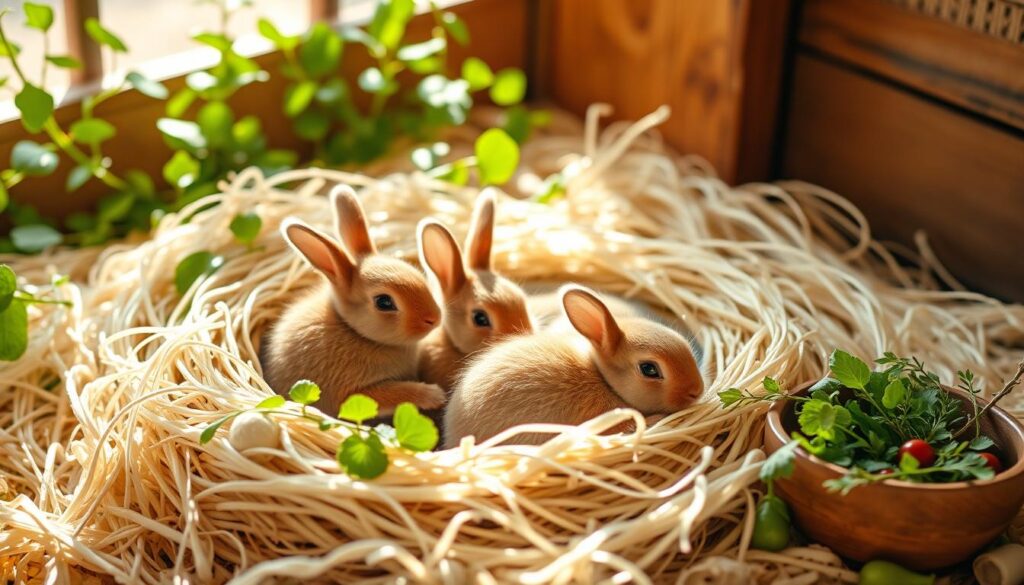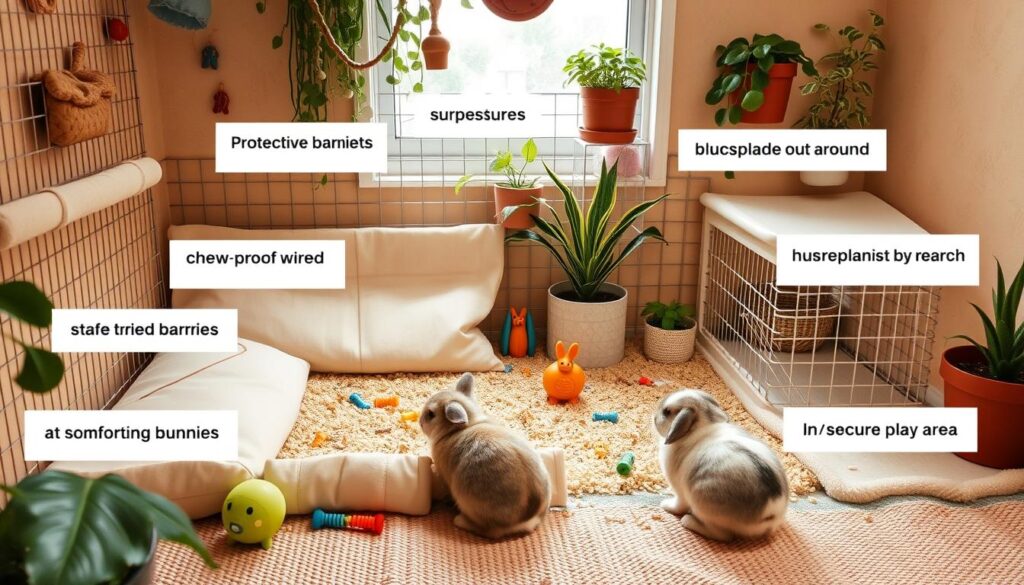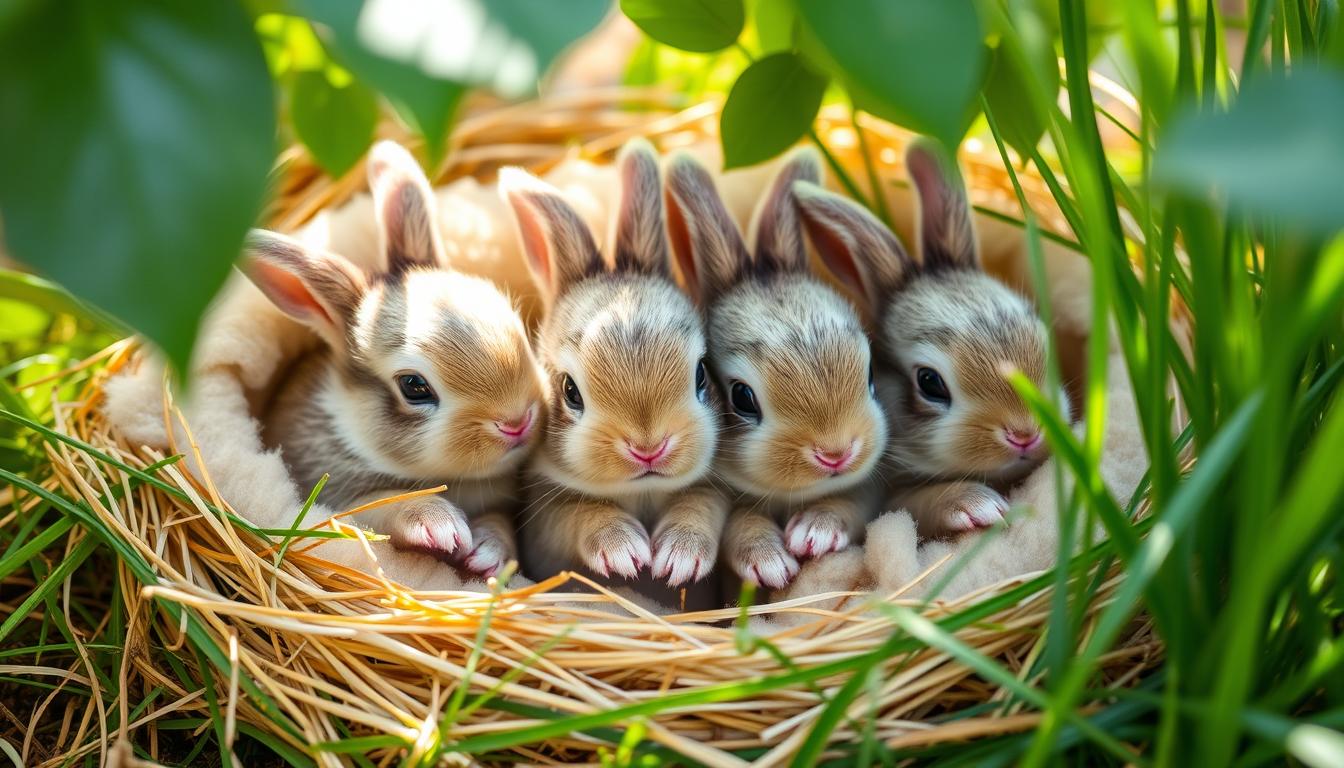I’ve always loved rabbits, and caring for newborn bunnies is especially special. Seeing those tiny, helpless kits for the first time was amazing. I wanted to share my knowledge to help others give their rabbits the best start.
Bringing newborn rabbit kits home is a big deal. It’s filled with joy and a lot of responsibility. These little ones need special care in their first weeks. This includes a safe place to nest, watching their health, and feeding them right.
In this guide, we’ll cover the key care needs for newborn bunny rabbits. You’ll learn everything you need to know to care for your kits. Whether you’re new to rabbit care or have experience, this guide will help your newborns grow strong and healthy.
Table of Contents
Understanding the First Days of Newborn Bunny Rabbits
Welcoming a new litter of rabbit kits is exciting but requires careful care. These tiny bunnies are helpless and need their mother and caregivers for survival. Knowing how to care for them is key to their healthy start.
Physical Characteristics of Newborn Kits
Newborn rabbit kits are born blind and deaf. They grow fast, getting their eyes and ears open around 10-12 days. At birth, they are tiny and rely on their mother’s milk and warmth.
Initial Care Requirements
Keeping their environment clean and stress-free is vital. The nest should be warm, around 100°F, to prevent cold. Feeding them often, 3 to 4 times a day, is also crucial.
Mother Rabbit’s Role
The mother rabbit is essential for her kits’ survival. She nurses them for about 5 minutes a day. If the kits are orphaned, they may need more frequent feedings to stay healthy.
“Caring for newborn rabbit kits requires patience, dedication, and a deep understanding of their unique needs. With the right approach, these delicate creatures can thrive and grow into healthy, happy bunnies.”
Setting Up the Perfect Nesting Environment
When caring for newborn bunny rabbits, it’s key to create a cozy nesting area. This space should be quiet, secure, and clean. It helps reduce stress for both the mother and her kits. A soft, absorbent bedding material in a cozy nesting box is a must.
To set up the perfect nesting environment, follow these key steps:
- Choose a nesting box that is large enough for the mother rabbit and her litter. Opt for a box made of durable, chew-proof materials.
- Line the nesting box with a soft, absorbent bedding material, such as wood chips or flakes. Avoid using cedar shavings, as they can be harmful to rabbits.
- Maintain the proper temperature and humidity levels in the nesting area, keeping it away from direct sunlight, radiators, and drafts.
- Regularly clean and replace the bedding to prevent the buildup of dirt, moisture, and any potential health issues.
- Encourage the mother rabbit to pull her own fur to line the nest, as this helps create a warm, cozy environment for the kits.
By creating a safe, comfortable, and clean nesting environment, you can help ensure the healthy development of newborn bunny rabbits during their critical early days.
| Nesting Behavior | Importance |
|---|---|
| Mama does failing to use nest boxes | Kits being scattered over the cage floor and even on the barn floor |
| Use of two nest boxes | Increase the chances of new mamas using a nest box |
| Shelving litters | In scenarios like rat infestation, extreme cold temperatures, mamas using nest box as a litter box, or for managing litter sharing |
By following these guidelines and understanding the importance of proper nesting behavior, you can create a safe and comfortable environment for your newborn bunny rabbits to thrive.
Feeding and Nutrition Guidelines for Baby Bunnies
Proper nutrition is key for newborn rabbit kits to grow well. The mother’s milk is full of nutrients and antibodies. If they need extra food, it’s important to use the right methods and start solid foods when they’re ready.
Mother’s Milk and Its Importance
Rabbit milk is very rich in calories, making it a great source of nutrients for kits. It has all the vitamins, minerals, and antibodies they need to thrive in their early life.
Supplemental Feeding Methods
If kits need extra food, use Kitten Milk Replacer or fresh goat milk with heavy whipping cream. Use a 3cc/ml syringe or eyedropper to feed them, keeping them upright to avoid choking. This method is crucial, as only a few hand-reared rabbits survive, showing the challenges involved.
Transitioning to Solid Foods
Start introducing alfalfa hay and pellets to kits at 3-4 weeks. Increase solid food amounts as they grow, helping them move from milk to a varied diet. By 6-8 weeks, give them unlimited hay and more pellets.
| Feeding Stage | Recommended Feeding Quantities |
|---|---|
| Newborn (up to 1 week) | 4-5 cc formula |
| 1-2 weeks | 10-15 cc formula |
| 2-3 weeks | 15-30 cc formula |
| 3-6 weeks | 30 cc formula until weaned |
For successful rabbit nutrition and bunny feeding, use a gradual, balanced approach. This ensures your baby bunnies get the right food for a healthy start.
Health Monitoring and Basic Medical Care
Caring for newborn rabbit kits is all about watching them closely. You need to check on them often to spot any health issues early. Taking care of their health from the start is crucial for their well-being.
Look for signs like a full belly, steady weight, and normal bowel movements. For the first two weeks, you might need to help with urination and bowel movements. Watch out for any cold-like symptoms, digestive problems, or changes in behavior.
If you see anything odd, get in touch with a vet who knows rabbits. Rabbits need special care, and their health risks under anesthesia are higher. Regular vet visits are a must to keep your baby bunnies healthy.
| Monitoring Aspect | Frequency | Key Considerations |
|---|---|---|
| Weight | Daily | Steady weight gain is a crucial indicator of health |
| Fur and Skin | Weekly | Inspect for any signs of skin irritation or abnormalities |
| Teeth and Nails | Weekly | Ensure proper growth and identify any issues early |
| Digestive Health | Daily | Monitor food intake, feces, and urination patterns |
| Behavior | Daily | Watch for any changes in activity, socialization, or alertness |
By keeping a close eye on your rabbit’s health, you can give them a great start. Remember, regular vet visits and quick action are vital for their rabbit health and bunny medical care.

Developmental Milestones in Baby Rabbits
Newborn bunny rabbits grow fast, showing many changes. Knowing these milestones helps you care for them well. Let’s look at the growth stages, behavior changes, and physical signs you’ll see.
Week-by-Week Growth Stages
At first, baby rabbits, or “kits,” are blind and deaf, depending on their mom. By 2-4 weeks, they get soft fur. Their eyes and ears open at 10-12 days, starting their exploration.
The growth is fast. By 4-8 weeks, they hop and explore, becoming more independent.
Behavioral Changes
As they grow, baby rabbits change a lot. Early on, they nurse and sleep a lot. But by 4-8 weeks, they start to play and explore, needing their mom less.
This is a big step in their rabbit behavior development. They become more confident and independent.
Physical Development Markers
Baby rabbits also change physically. Their fur grows, and their eyes and ears open. By 4-5 weeks, their teeth come in, and they can be handled gently.
They gain weight, get better at moving, and show their rabbit features. These changes help them grow into healthy adult rabbits.
Watching your newborn bunny’s growth closely is important. It helps them become a healthy, well-adjusted adult. Knowing their growth patterns and needs lets you give them the best care.
Creating a Safe Environment for Growing Bunnies
As your newborn rabbit kits grow, it’s key to make their space safe. Rabbit-proofing your home is vital to keep your pets safe and avoid dangers. Remove any electrical cords, toxic plants, and small items that might attract their chewing.
Give your bunnies safe chew toys to keep them busy and healthy. Also, make sure they have a big area for play. Add hiding spots and tunnels to keep them curious and secure.
- Secure all electrical cords and wires to prevent chewing and potential electrocution
- Identify and remove any toxic plants or flowers that could be harmful if ingested
- Eliminate small objects that could pose a choking hazard or be swallowed by your curious bunnies
- Provide a variety of safe chew toys, such as wooden blocks, hay-based products, or specialty bunny toys
- Designate a spacious area for your bunnies to explore and play, with hiding spots and tunnels for mental enrichment
By making a safe and fun space, your rabbits will thrive. Remember, rabbit-proofing and bunny safety are crucial for their happiness and health as they explore.

“Creating a safe, enriching environment for your growing bunnies is a labor of love that pays off in countless ways.”
Socializing and Handling Young Rabbits
Introducing your new bunny to the world can be exciting and rewarding. But, it’s important to do it right. When it comes to rabbit socialization and bunny handling, there are some best practices to keep in mind.
Best Practices for Human Interaction
Start socializing your baby rabbits around 4-5 weeks old. Gently handle them often to build trust and confidence. Always support their body when lifting, and never pick them up by the ears or scruff. This can be very stressful and even lead to serious injuries.
Spend time near their enclosure, speaking softly to help them get used to your presence. Gradually introduce new experiences and environments. This helps them become more comfortable and curious about their surroundings.
Building Trust and Confidence
- Interact with your rabbit at ground level to reduce fear and minimize the risk of accidental dropping.
- Avoid restraining your rabbit more than necessary, as this can cause stress and anxiety.
- Use positive training methods, such as ‘clicker’ training, to teach your rabbit new skills without causing fear or discomfort.
The key to successful rabbit socialization and bunny handling is to take it slow, be gentle, and build trust and confidence. With patience and care, your rabbit will learn to enjoy your company and thrive in their new environment.
Common Health Issues in Newborn Bunny Rabbits
Caring for newborn bunny rabbits, or “kits,” is a big responsibility. They can get sick with many common problems. It’s important to watch them closely for health issues like stomach problems, breathing infections, and dental issues.
Respiratory Infections and Snuffles
Upper respiratory infections, or “snuffles,” are common in young rabbits. These infections can cause runny eyes, a runny nose, and sneezing. If not treated, they can turn into serious diseases like pneumonia.
Skin and Parasite Issues
Young rabbits can also have skin problems. These can be from fleas, ringworm, or even accidents in their living area. Boys might get abscesses, which are painful and need a vet.
Dental and Gastrointestinal Concerns
Rabbits often have dental issues. This can be because of their teeth, diet, or lack of sunlight. They can also get a slow digestive system, which hurts and makes them lose weight.
Keeping their living area clean and feeding them right is key. Watch them for any signs of sickness. If you see something wrong, see a vet fast. Early treatment can help a lot.
“Proactive healthcare and preventative measures are the keys to keeping your newborn bunnies healthy and thriving.”
| Common Health Issue | Symptoms | Potential Causes | Treatment |
|---|---|---|---|
| Respiratory Infections (Snuffles) | Runny eyes, runny nose, sneezing | Pasteurella or Bordetella bacteria, poor living conditions | Antibiotics, nebulizer treatments, supportive care |
| Skin Problems | Fleas, ringworm, urine scald, abscesses | Inadequate hygiene, poor hutch cleaning | Topical treatments, antibiotics (for abscesses) |
| Dental Issues | Overgrown or misaligned teeth | Abnormal anatomy, poor diet, lack of sunlight | Dental trimming, dietary adjustments |
| Gastrointestinal Stasis | Decreased appetite, weight loss, constipation | Dietary imbalances, stress, underlying conditions | Fluid therapy, pain medication, dietary changes |
Weaning Process and Transition to Independence
The weaning process for [rabbit weaning] starts around 3-4 weeks and finishes by 8 weeks. It’s key to slowly introduce solid foods while still giving mother’s milk. Offer your bunny alfalfa hay, pellets, and small veggies.
As your [bunny independence] kit grows, you’ll see big changes. They’ll nurse less and explore more. It’s good to keep males and females apart by 3-4 months. Also, spaying or neutering them at 4-6 months is best for their health.
Dietary Changes During Weaning
Start by giving your kit small amounts of hay, pellets, and veggies with their milk. Slowly add more solid food and less milk over weeks.
Behavioral Adjustments
Your [rabbit weaning] kit will act differently as they grow. They’ll nurse less and play more. This is normal, so be patient and supportive.
The weaning and growing up are big steps for your [bunny independence] rabbit. With care and the right food, they’ll make a smooth transition.
Conclusion
Caring for newborn bunny rabbits needs dedication, patience, and a deep understanding of their needs. Proper newborn bunny care means giving the right food, watching their health, and making a safe place for them to grow.
As these baby rabbits get older, teaching them to socialize and become independent is key. With the right tips and care, your newborn bunnies will grow into happy, healthy adult rabbits. They can live up to 10-15 years as loving pets.
Remember, caring for newborn rabbits is rewarding but also demanding. By being informed, prepared, and committed, you can help these delicate creatures thrive. Enjoy the challenges and joys of raising these special animals.


1 thought on “How to Care for Newborn Bunny Rabbits: Essential Guide”